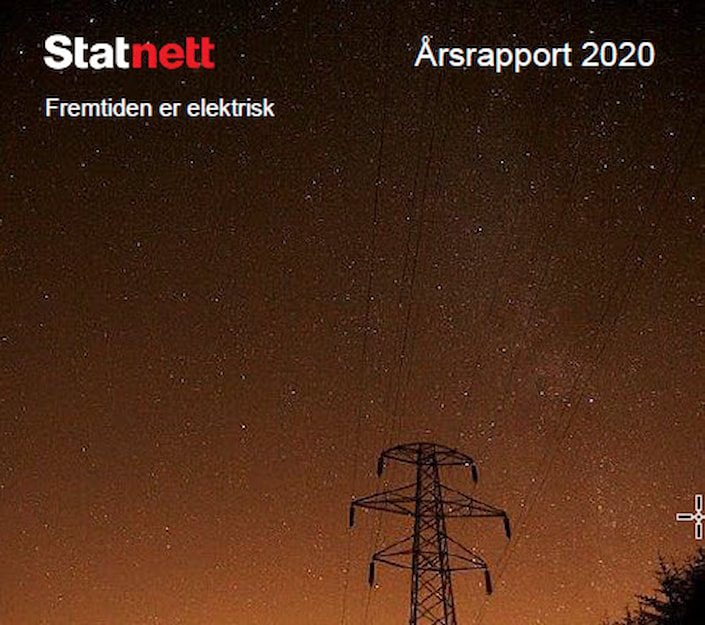As for the society, the Covid-19 pandemic has affected Statnett throughout 2020. Extensive infection prevention measures have been put in place at an early stage. The measures have been necessary to ensure security of supply, safeguard key operational personnel and to contribute to the nationwide effort to limit the spread of the virus. Strict measures throughout the country have created challenges for construction projects. Statnett has a robust emergency response organization, and the supply security during 2020 has been satisfactory and the power situation has been good.
In many ways, 2020 was an unusual year for the power system. Production reached record high 153 TWh, compared to an average production of just above 140 TWh during the last ten years. The increase was caused by an abundance of snow in the mountains from the winter of 2019/2020 and high precipitation through the year. Power prices were unusually low, at the same time consumption was on the level of the last 5 years, with 132.9 TWh. Net exports was somewhat above average, even though damages, longer faults and maintenance outages resulted in reduced international trading capacity.
Annual results
In 2020 Statnett achieved and underlying annual result after taxes of NOK 2,079 million (NOK 2 523 million in 2019). The recorded annual result after taxes was NOK 2,697 million (1,906). Annual investments were NOK 7,298 million (9,618). The improvement is mainly caused by a record high congestion income.
The operating expenses have increased as a result of higher activity in the Group. Statnett's efficiency program has contributed to a lower cost growth than the corresponding increase in activity and asset base. Recorded operating revenues were NOK 10,761 million (9,641), the highest ever recorded.
Congestion revenue and grid tariffs
The Norwegian Energy Regulatory Authority (NVE-RME) has authorized Statnett to build up a lower revenue in 2021 and thus reduce the grid tariffs on a temporary basis with NOK 1,25 million versus 2020. This measure is taken to somewhat elevate the negative financial consequences which the Covid 19-pandemic has caused for Norwegian consumers and businesses.
Total congestion revenues increased to a record high NOK 2,408 million in 2020 (587). The increase is caused by major price differences between Norway and other countries caused by materially lower electricity prices in Norway compared to foreign markets, combined with a weaker exchange rate for the NOK against the SEK and EUR. The increased congestion revenues will be used to reduce future grid tariffs.
Paving the way for a fully electrified society
Despite the constraints caused by the Covid-19 pandemic, the Group maintained a high investment level. Statnett invested for NOK 6,754 million in grid infrastructure in 2020 (7 433). Statnett built 105 km of new power lines and put 59 field circuit breakers into operation at its substations.
The NordLink interconnector to Germany, which is 623 kilometers long, was completed, and made available for trial operations on December 8. The NordLink cable will contribute to increased value creation, security of supply and help achieve Norwegian and European climate goals. The progress on the construction of the North Sea Link interconnector to the UK, which will be put into operation in 2021, was also satisfactory.
Towards the end of the year a 420 kV power cable between Balsfjord and Skillemoen outside Alta was entered into operation. This marks the first time that the county of Finnmark is connected at this voltage level and constitutes a considerable lift for the supply situation in the Northern region. The 420 kV upgrade of the transmission grid in the South Western part of Norway through the Western Corridor project continued throughout 2020. This major project started in 2015 and the planned completion is set for October 2021.
HSE- activities are prioritized
Statnett has, also in 2020 achieved a reduction in the numbers of accidents injuries with personnel injuries with and without leave of absence. Especially, there was a significant reduction in the internal injury frequency. External suppliers in Statnett’s projects maintained their results from 2019, when a large reduction in personnel injuries was achieved, compared to previous years.
Even though 2020 showed a reduction in the number of personal injuries within the Group, the year is marred by a fatal incident on the Lyse-Fagrafjell project. An employee of a sub-contractor died after an accident involving an All-Terrain Vehicle on July 13. The inquiry into the accident found no evidence that the incident could be linked to Statnett and a failure to comply with the Construction Client Regulations.
Outlook: The green shift continues
Increased electrical power demand, wind- and solar production and out phasing of fossil fuel driven and nuclear power plants means a radical change to the power systems in Europe and the Nordics. The power system in Norway changes through a more rapid electrification to reach the climate goals, more wind power and increased international exchange of electrical power. Norway is becoming more tightly linked into the European energy system, through shared climate obligations, increased power exchange capacity and shared regulations and market solutions.
Statnett will have to maintain a consistently high investment level in order to meet these demands in the coming years. Statnett expects that the need for grid capacity will increase towards 2030, since the transfer to a zero-emission society is occurring at an increasing speed.
Considerations relating to both the climate and the natural environment will increasingly influence the development of the energy system and guide how Statnett performs its tasks. Such considerations will, for example, influence where our new power transmission facilities are built, how they are built and what Statnett should do to exploit the existing infrastructure as effectively as possible, thereby reducing the need for additional investment. Effective market solutions, good sectoral regulation, R&D and digitalization will all be important to limit both costs and the company’s impact on the environment.
The annual report was published on Thursday March 11 and can be read in its entirety below on this page.

